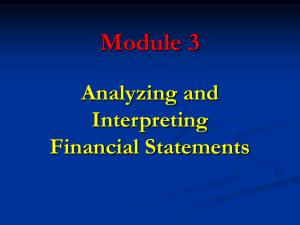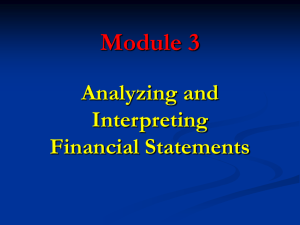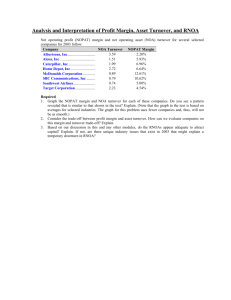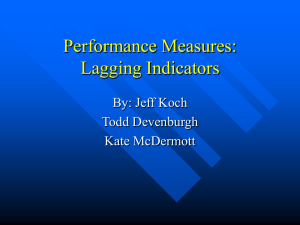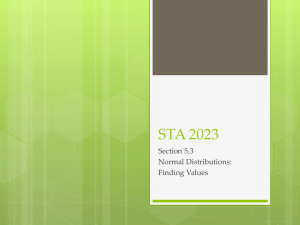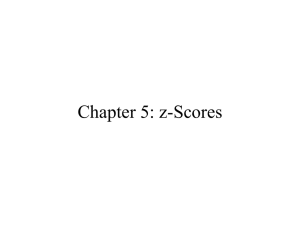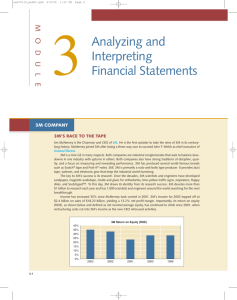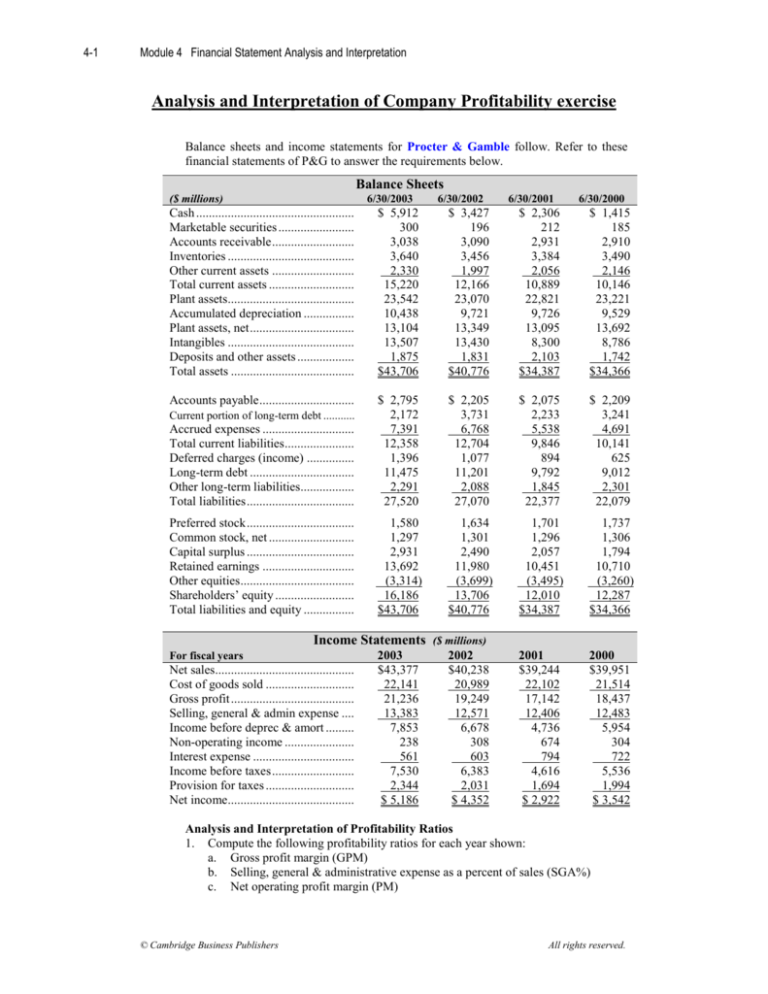
4-1
Module 4 Financial Statement Analysis and Interpretation
Analysis and Interpretation of Company Profitability exercise
Balance sheets and income statements for Procter & Gamble follow. Refer to these
financial statements of P&G to answer the requirements below.
Balance Sheets
($ millions)
6/30/2003
6/30/2002
6/30/2001
6/30/2000
Cash .....................................................
Marketable securities ...........................
Accounts receivable .............................
Inventories ...........................................
Other current assets .............................
Total current assets ..............................
Plant assets...........................................
Accumulated depreciation ...................
Plant assets, net ....................................
Intangibles ...........................................
Deposits and other assets .....................
Total assets ..........................................
$ 5,912
300
3,038
3,640
2,330
15,220
23,542
10,438
13,104
13,507
1,875
$43,706
$ 3,427
196
3,090
3,456
1,997
12,166
23,070
9,721
13,349
13,430
1,831
$40,776
$ 2,306
212
2,931
3,384
2,056
10,889
22,821
9,726
13,095
8,300
2,103
$34,387
$ 1,415
185
2,910
3,490
2,146
10,146
23,221
9,529
13,692
8,786
1,742
$34,366
Accounts payable .................................
Accrued expenses ................................
Total current liabilities .........................
Deferred charges (income) ..................
Long-term debt ....................................
Other long-term liabilities....................
Total liabilities .....................................
$ 2,795
2,172
7,391
12,358
1,396
11,475
2,291
27,520
$ 2,205
3,731
6,768
12,704
1,077
11,201
2,088
27,070
$ 2,075
2,233
5,538
9,846
894
9,792
1,845
22,377
$ 2,209
3,241
4,691
10,141
625
9,012
2,301
22,079
Preferred stock .....................................
Common stock, net ..............................
Capital surplus .....................................
Retained earnings ................................
Other equities.......................................
Shareholders’ equity ............................
Total liabilities and equity ...................
1,580
1,297
2,931
13,692
(3,314)
16,186
$43,706
1,634
1,301
2,490
11,980
(3,699)
13,706
$40,776
1,701
1,296
2,057
10,451
(3,495)
12,010
$34,387
1,737
1,306
1,794
10,710
(3,260)
12,287
$34,366
2001
$39,244
22,102
17,142
12,406
4,736
674
794
4,616
1,694
$ 2,922
2000
$39,951
21,514
18,437
12,483
5,954
304
722
5,536
1,994
$ 3,542
Current portion of long-term debt ..............
Income Statements ($ millions)
For fiscal years
Net sales...............................................
Cost of goods sold ...............................
Gross profit ..........................................
Selling, general & admin expense .......
Income before deprec & amort ............
Non-operating income .........................
Interest expense ...................................
Income before taxes .............................
Provision for taxes ...............................
Net income...........................................
2003
$43,377
22,141
21,236
13,383
7,853
238
561
7,530
2,344
$ 5,186
2002
$40,238
20,989
19,249
12,571
6,678
308
603
6,383
2,031
$ 4,352
Analysis and Interpretation of Profitability Ratios
1. Compute the following profitability ratios for each year shown:
a. Gross profit margin (GPM)
b. Selling, general & administrative expense as a percent of sales (SGA%)
c. Net operating profit margin (PM)
© Cambridge Business Publishers
All rights reserved.
4-2
Module 4 Financial Statement Analysis and Interpretation
2.
d. Net profit margin.
Your results in part 1 should have revealed an increase in net profit margin.
a. Is this increase due to an increase in the gross profit margin or a decrease in
selling, general, & administrative expense, or both? Provide evidence and
explain your answer.
b. Consider how much control that companies have or do not have over gross
profit margins. What factors must exist to allow them to increase selling prices
of their products? In what ways can they improve gross profit margins by
lowering product manufacturing costs? Explain.
c. What are the usual components of selling, general and administrative expense
for a company like Procter and Gamble? For which of these components are
companies likely able to achieve expense reductions? To what extent are these
expense reductions a short-term gain at the cost of long-term performance?
Explain.
Analysis and Interpretation of Asset Turnover Ratios
1. Compute the following turnover ratios for 2001 through 2003:
a. Accounts receivable turnover and the average collection period.
b. Inventory turnover and average inventory days outstanding.
c. Plant asset turnover.
2. Results from part 1 should reveal a slight improvement in receivables turnover
from 2001 to 2003. How can a company like P&G realize an improvement in this
ratio? Explain.
3. Results from part 1 should reveal no discernable improvement in inventory
turnover from 2001 to 2003. How can a manufacturer like P&G realize an
improvement in its inventory turnover? Explain.
4. Results from part 1 should reveal a slight decline in plant asset turnover from 2001
to 2003. Why is this ratio so difficult for companies to impact? Can you think of
ways in which a company can achieve an improvement in this ratio? Explain.
Disaggregation and Interpretation of Company ROE
1. Compute the following for 2001 through 2003:
a. Net operating profit margin (PM).
b. Return on net operating assets (RNOA).
c. Financial leverage (LEV).
d. Net borrowing costs (NBC)
e. Spread
f. Return on equity (ROE).
g. ROE from the formula: ROE = RNOA + (LEV×Spread). Confirm that this
amount equals that computed in part f.
2. Drawing on results from part 1, does P&G depend more on operations (RNOA) or
financial leverage to drive its ROE? Explain.
3. Drawing on results from part 1, is P&G’s level of ROE sufficient to attract capital?
Explain. What benchmark do you believe is appropriate in answering that
question? Explain.
Analysis and Interpretation of Liquidity and Solvency Measures
1. Compute its current ratio and quick ratio for 2001 through 2003. Do the trends, if
any, in these ratios indicate that P&G is becoming more or less liquid? Use
computations to support your analysis and inferences.
2. Compute P&G’s financial leverage (LEV) and times interest earned for 2001
through 2003. Do these ratios indicate that P&G is becoming more or less solvent?
Explain.
3. A well-known model of financial distress is Altman’s Z-score. Altman’s Z-
score uses multiple ratios to get a predictor of distress. This predictor classifies
or predicts the likelihood of bankruptcy or nonbankruptcy. Five financial ratios
© Cambridge Business Publishers
All rights reserved.
4-3
Module 4 Financial Statement Analysis and Interpretation
makeup the Z-score:
X1 = Working capital / Total assets
X2 = Retained earnings / Total assets
X3 = Earnings before interest and taxes / Total assets
X4 = Shareholders’ equity / Total liabilities
X5 = Sales / Total assets.
In brief, X1 reflects liquidity, X2 reflects cumulative profitability that has been
retained, X3 reflects profitability, X4 reflects financial leverage, and X5
reflects total asset turnover.
The Altman Z-score is computed as:
Z-score = (0.717 × X1) + (0.847 × X2) + (3.107 × X3) + (0.420 × X4) + (0.998 ×
X5)
The Z-score is then interpreted as follows:
Z-score < 1.20
high probability of bankruptcy
Z-score > 2.90
low probability of bankruptcy
1.20 ≤ Z-score ≤ 2.90
gray or ambiguous area.
Compute the Altman Z-Score of P&G for 2003. Does this score indicate any concerns
about P&G’s solvency? Explain.
© Cambridge Business Publishers
All rights reserved.


